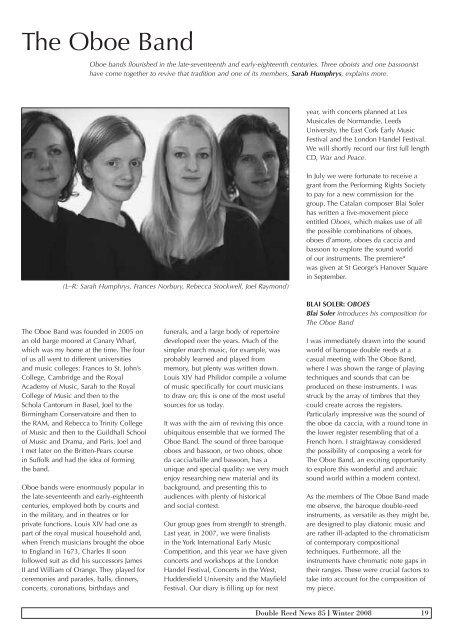Double Reed 70 cover - British Double Reed Society
Double Reed 70 cover - British Double Reed Society
Double Reed 70 cover - British Double Reed Society
Create successful ePaper yourself
Turn your PDF publications into a flip-book with our unique Google optimized e-Paper software.
The Oboe Band<br />
The Oboe Band was founded in 2005 on<br />
an old barge moored at Canary Wharf,<br />
which was my home at the time. The four<br />
of us all went to different universities<br />
and music colleges: Frances to St. John’s<br />
College, Cambridge and the Royal<br />
Academy of Music, Sarah to the Royal<br />
College of Music and then to the<br />
Schola Cantorum in Basel, Joel to the<br />
Birmingham Conservatoire and then to<br />
the RAM, and Rebecca to Trinity College<br />
of Music and then to the Guildhall School<br />
of Music and Drama, and Paris. Joel and<br />
I met later on the Britten-Pears course<br />
in Suffolk and had the idea of forming<br />
the band.<br />
Oboe bands were enormously popular in<br />
the late-seventeenth and early-eighteenth<br />
centuries, employed both by courts and<br />
in the military, and in theatres or for<br />
private functions. Louis XIV had one as<br />
part of the royal musical household and,<br />
when French musicians brought the oboe<br />
to England in 1673, Charles II soon<br />
followed suit as did his successors James<br />
II and William of Orange. They played for<br />
ceremonies and parades, balls, dinners,<br />
concerts, coronations, birthdays and<br />
Oboe bands flourished in the late-seventeenth and early-eighteenth centuries. Three oboists and one bassoonist<br />
have come together to revive that tradition and one of its members, Sarah Humphrys, explains more.<br />
(L–R: Sarah Humphrys, Frances Norbury, Rebecca Stockwell, Joel Raymond)<br />
funerals, and a large body of repertoire<br />
developed over the years. Much of the<br />
simpler march music, for example, was<br />
probably learned and played from<br />
memory, but plenty was written down.<br />
Louis XIV had Philidor compile a volume<br />
of music specifically for court musicians<br />
to draw on; this is one of the most useful<br />
sources for us today.<br />
It was with the aim of reviving this once<br />
ubiquitous ensemble that we formed The<br />
Oboe Band. The sound of three baroque<br />
oboes and bassoon, or two oboes, oboe<br />
da caccia/taille and bassoon, has a<br />
unique and special quality: we very much<br />
enjoy researching new material and its<br />
background, and presenting this to<br />
audiences with plenty of historical<br />
and social context.<br />
Our group goes from strength to strength.<br />
Last year, in 2007, we were finalists<br />
in the York International Early Music<br />
Competition, and this year we have given<br />
concerts and workshops at the London<br />
Handel Festival, Concerts in the West,<br />
Huddersfield University and the Mayfield<br />
Festival. Our diary is filling up for next<br />
year, with concerts planned at Les<br />
Musicales de Normandie, Leeds<br />
University, the East Cork Early Music<br />
Festival and the London Handel Festival.<br />
We will shortly record our first full length<br />
CD, War and Peace.<br />
In July we were fortunate to receive a<br />
grant from the Performing Rights <strong>Society</strong><br />
to pay for a new commission for the<br />
group. The Catalan composer Blai Soler<br />
has written a five-movement piece<br />
entitled Oboes, which makes use of all<br />
the possible combinations of oboes,<br />
oboes d’amore, oboes da caccia and<br />
bassoon to explore the sound world<br />
of our instruments. The premiere*<br />
was given at St George’s Hanover Square<br />
in September.<br />
BLAI SOLER: OBOES<br />
Blai Soler introduces his composition for<br />
The Oboe Band<br />
I was immediately drawn into the sound<br />
world of baroque double reeds at a<br />
casual meeting with The Oboe Band,<br />
where I was shown the range of playing<br />
techniques and sounds that can be<br />
produced on these instruments. I was<br />
struck by the array of timbres that they<br />
could create across the registers.<br />
Particularly impressive was the sound of<br />
the oboe da caccia, with a round tone in<br />
the lower register resembling that of a<br />
French horn. I straightaway considered<br />
the possibility of composing a work for<br />
The Oboe Band, an exciting opportunity<br />
to explore this wonderful and archaic<br />
sound world within a modern context.<br />
As the members of The Oboe Band made<br />
me observe, the baroque double-reed<br />
instruments, as versatile as they might be,<br />
are designed to play diatonic music and<br />
are rather ill-adapted to the chromaticism<br />
of contemporary compositional<br />
techniques. Furthermore, all the<br />
instruments have chromatic note gaps in<br />
their ranges. These were crucial factors to<br />
take into account for the composition of<br />
my piece.<br />
<strong>Double</strong> <strong>Reed</strong> News 85 Winter 2008 19


